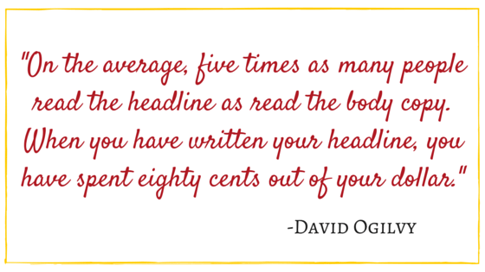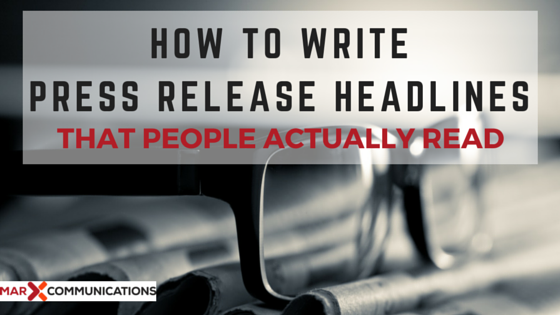To be fair, I haven’t actually seen Snakes on a Plane. And, in all honesty, the title has its good points: It’s succinct and we get a very clear vision of what the movie is all about. If only all press release headlines incorporated that measure of clarity, but without the negative press attention. Take a look at a couple of examples of headlines that make you go hmmm….
Example #1:

Now, granted this one isn’t awful. But it doesn’t say anything exciting — or new. Don’t we already know that car companies are making things greener?
Example #2:

What’s wrong with this one, other than that it has the excitement of a washing machine repair manual? Well, it makes it sound like Dell is doing something philanthropic, when in reality, the news is that Dell is teaching people how to use its product. Who cares?
Example #3:
Where to start with this one? First, it’s way too long, and the title isn’t even capitalized. And, “That Dream Bigger Property?” Am I being encouraged to dream bigger, or is the property itself bigger?
How could these have been improved upon? Well, let’s try a few variations:
1. Honda, Nissan, and Toyota Unite to Create a More Eco-Friendly World
2. Dell’s Teaching and Learning Academy Makes Using its Products a Snap
3. 4 Steps to Secure Your Dream Property
Now, for a few stellar examples of press release headlines:
This gets you curious and laughing at the funny mental image. Plus, this is great PR for a company that functions in an industry receiving constant scrutiny. Good going, United.
Besides being a big fan of Square products, I like the simplicity of this headline. I’m wondering how Square Cash works, so I click on the search engine friendly headline.
This one is just about perfect in length, it elicits an emotional response (aren’t you curious to see the video?), it plays off of a trending topic (soccer), and you have the added bonus of knowing there’s a video waiting.

Analyzing other headlines is a great way to get a feel for what works and what doesn’t. However, there are a few tried and true ingredients to make your headline a success. A pinch of each of these tips will go a long way to getting your headline (and release) noticed.
1. Make it Short and Sweet
Long headlines will get truncated in many readers and search engines. And readers and search engines aren’t the only ones who get bored with long titles. People want to look at your headline and get an immediate idea for what your release is all about.
Try this:
Keep it to a hundred characters or less for optimal text appeal.
2. Make it Twitter Friendly
This concept falls in line with keeping it short. However, your social media audience is ever more conscious and appreciative of pithy wording. When you create your headline, make sure to word it so it will be easy promote on social media.
3. Make it Powerful
Using passive voice can be… well…. kind of… weak. You get the idea.
The truth is:
Using passive voice weakens your message (That’s better, right?). Instead, use active voice. Active voice writing is much more powerful and makes you sound like a leader.
4. Make it Emotional
Even the most hard-core executive has an emotional side. It’s just plain human nature. Tap into this by creating headlines that elicit emotions such as humor, anger, and curiosity.
5. Make it the Last Thing You do
Some may argue this point saying your headline sets the tone for your release. However, after you create your release, you’ll have a better overall picture of the image you want to present and the feeling you want to create. Make your headline the last thing you create and you’ll see how to better incorporate your thoughts into one well-honed headline.
6. Make it Trendy
Use keywords in your headline that are popular on social networks. In other words, be aware of the terminology that is commonly used. If you commonly use the term B2B Public Relations, but hashtags on Twitter are using B2B PR, then make sure you use the more common version in your headline.
7. Make it Something You’d Want to Know About
It may sound self-evident, but you want to write a headline in a way that you find interesting to read. It can be all too easy to get caught up in just putting the information out there without stopping to think of whether or not it would actually catch your eye if you were the reader.
8. Make it SEO-Friendly
Remember that although you are writing for people, you’re also writing for search engines. Place keywords not only throughout your release and in subheadings, but prominently in your headline. They should be the in first 1-3 words.
9. Make it Pass the Test with Flying Colors
Using a headline analyzer, such as the one CoSchedule offers, isn’t a sure win against headline failure, but it helps you to get your footing. Enter your headline, and you’ll see how to improve on your working title.
For instance, if I plug in How to Write Press Release Headlines, I get a score of 65 and a grade of C-. Yep, it’s a yawn. It has no scoring among common words, powerful words, or uncommon words. It received a 33% on an emotional level. You are aiming for a balance between all four groups.
So, if I put in How to Write Press Releases That People Read, I receive a score of 68 and a grade of A+ for my word balance. Not bad. A score around 70 or above is considered excellent.
Writing a kick-butt headline is truly one of the best things you’ll do to get your release noticed. However, for every thoughtless headline, there is an equally staggering number of thoughtless releases that follow suit. How can you be sure that yours isn’t one of them?
Check out our guide: How to Write Press Releases That Don’t Suck. Inside, you’ll learn about five ways to create captivating press releases, plus how to use your press release to drive traffic and leads.








